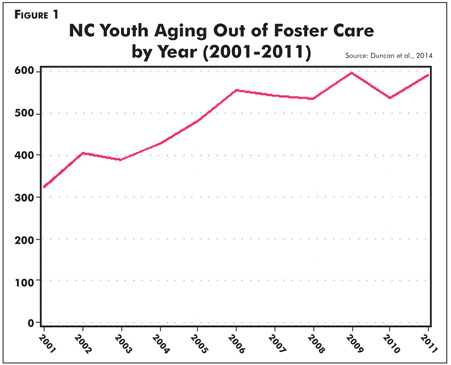 |
 |
 |
Vol.
19, No. 2
March 2014
Achieving Legal and Relational Permanence for ALL Youth in Foster Care
Every youth in foster care deserves a permanent home. Ideally, this takes place through legal permanence, which is defined as the reunification, adoption, or transfer of legal guardianship of the youth. However, even if that isn't possible, achieving relational permanence is key.
Relational permanence means "lifelong connections to caring adults, including at least one adult who will provide a permanent, parent-like connection for that youth" (Louisell, 2008). Recognizing the importance of relational permanence, North Carolina has made it one of the primary outcomes focused on by NC LINKS, our state's independent living program. For each teen in foster care we seek to build "a personal support system of at least five caring adults in addition to professional relationships."
Permanence Matters
Legal and relational permanence matter so much because those who age out are at an increased risk for many negative outcomes. Consider the findings of Courtney and colleagues (2011). These researchers followed youth who aged out of foster care and are now 26 years old. Compared to a representative sample of their peers who did not spend time in foster care, these youth were:
- 10.5 times more likely to be in prison or jail.
- 3 times less likely to have completed high school.
- 9 times less likely to have completed a 4-year degree.
- Nearly twice as likely to have a health condition or disability that limits their daily activity.
- Nearly twice as likely to be unemployed.
Aging Out of Foster Care in NC
In 2012, 535 youth aged out of foster care in our state, a number that has steadily increased over the past decade (see figure 1). Of these youth, 62% first entered foster care when they were 13 or older (Duncan, et al., 2014).

According to the US Department of Health and Human Services, Children's Bureau (2014) in North Carolina a 12-year-old in foster care is 2.5 times less likely to be adopted, and a 17-year-old 9 times less likely to be adopted, than a 2-year-old.
Although adoption is not the only path to legal permanence, many older youth are at risk of aging out without legal permanence of any kind.
Tool for Building Connection and Support
Whether or not they age out of care, all youth need emotional connection and support. The Permanency Pact is one approach to helping them achieve it.
This planning tool was developed by FosterClub (www.fosterclub.org) to help youth and supportive adults establish, define, and maintain a relationship that is supportive for the youth. To establish a Permanency Pact a facilitator, such as a case worker, helps the youth identify adults they would like to have in their support system.
The facilitator then guides the process of expanding the youth's support system, which involves obtaining consents to share information, helping make contact with the adult, facilitating conversations between the youth and adult, and helping establish a written pact.
FosterClub's free, brief, easy-to-use Permanency Pact toolkit includes 45 potential supports that a supportive adult could provide to a foster youth to help establish relational permanency. These include supports such as a home for the holidays, occasional family style meals, spiritual support, storage space, mentoring, and more.
To learn more, download the Permanency Pact toolkit: http://fclub.he2236.vps.webenabled.net/content/fosterclubs-permanency-pact.
3-5-7 Model
The Permanency Pact's focus on involving youth is consistent with another model's emphasis on youth engagement.
Developed by Dr. Darla Henry, the 3-5-7 Model helps children and youth prepare for permanency by encouraging them to reflect on who they are, what has happened to them, where they are headed, how they will get there, and when they will know that they belong. The model incorporates 3 tasks, 5 conceptual questions and 7 interpersonal skill elements to support this work. These are shown in the figure below.
The 3-5-7 Model |
Three tasks to support grief work and building relationships:
|
Five questions to support the work of the three tasks:
|
Seven skills to support the work of children, youth and families:
Sources: www.cebc4cw.org; Darla L. Henry & Associates, 2014 |
The 3-5-7 model also gives special consideration to the trauma and grief children have experienced rather than labeling a child as having a behavior disorder. The California Evidence-Based Clearinghouse finds this model highly relevant to child welfare work; however, there is not yet enough empirical evidence of its effectiveness to give it a scientific rating. This may change: 3-5-7 is currently going through rigorous evaluation.
Conclusion
Youth in foster care, like everyone else, crave connection. Social work researcher Brene Brown (2010) defines connection as, "the energy that exists between people when they feel seen, heard, and valued; when they can give and receive without judgment; and when they derive sustenance and strength from the relationship" (p. 19).
Whether this connection comes through legal or relational permanence, it is vital that we ensure connection for every young person.
